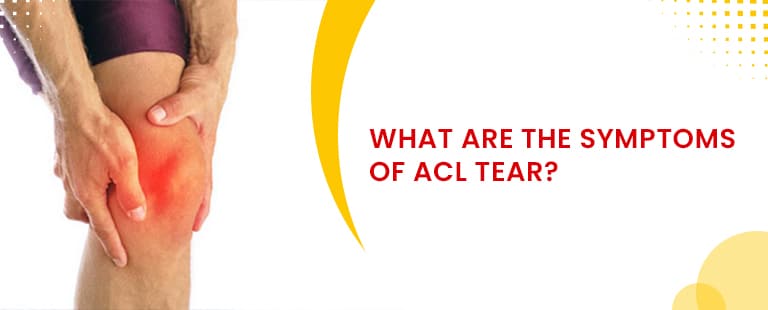ACL, or anterior cruciate ligament, is one of the four primary bands of tissues, or ligaments in your knees, that connect the three bones, namely femur (thigh bone), tibia (shin bone) and patella (kneecap), in your joint. The ACL helps you control your knee’s movements in several directions and also stabilises it.
Athletes playing certain sports may be more at risk for an ACL tear or sprain. These sports may specifically require you to be intensely active while performing a sudden change of direction. These high-intensity sports that may increase the risk of ACL injuries include football, rugby, basketball, etc. Also, you may suffer from an ACL injury due to a sudden and direct impact on your knee.
So let’s discuss the symptoms of a knee ACL tear and other injuries.
Symptoms Of ACL Ligament Tear
ACL tear is one of the most common knee-related injuries. If you have suffered from an ACL tear in the past, you may be well aware of its signs and symptoms. The most prevalent of the symptoms you have after tearing your ACL:
- Pain: ACL tear is one of the injuries resulting in severe pain, one of the prevalent symptoms.
- Instability: Your knee will become incredibly unstable and may even buckle (give out) when you try to move or stand.
- Popping sound: One of the prevalent symptoms of an ACL tear is the sound of pop during physical activity.
- Walking inability: Due to the pain and instability, you may not be able to and don’t even want to put weight on your leg afflicted with an ACL tear.
- Swelling: The tear in your ACL will cause you to have swelling in your knee
You may experience these symptoms and more due to ACL tears. But the extent of these symptoms will depend a lot on the severity of the tear and your pain threshold.
You may also wonder about the location of pain in an ACL tear. Although some people are lucky enough to get away with mild pain, most with a tear in their ACL may experience a lot of pain, typically around the centre of their knee.
Partial ACL Tear
There are different types of ACL injuries, and not everyone will suffer from a complete ACL tear. ACL injuries fall under three categories, with Grade 1 ACL injuries being classified as the mildest ones. Then there are grade 2 ACL injuries, including situations where a person’s ACL is either partially torn or has gotten loose or stretched. Finally, grade 3 includes the complete tear in your anterior cruciate ligament.
People playing intense-activity sports may experience an injury known as a partial ACL tear. It means that the person has either loosened or stretched the ligament or had a tear in one or two ACL-forming bundles. Although not as much as a complete tear, a partial ACL tear will also be quite painful and result in swelling. In this injury, instability in the knee will vary from person to person.
ACL Strain
The least severe type of ACL injury is an ACL sprain. Your anterior cruciate ligament may suffer a strain due to being stretched beyond the limit. Although it won’t result in a tear, it will still be quite painful.
Diagnostic Tests For ACL Tear
The first step of diagnosis of any medical condition is a physical test. In this test, your doctor will examine your symptoms and test the range of your knee’s motion.
Afterwards, the doctor will perform a Lachman test. In this test, you will be asked to lay on your back. Then the doctor will try to move and bend your knee to analyse its movement ability and the extent of the injury.
Another test for this injury is the anterior drawer test, in which your knee is bent and pressure is applied behind it. If your leg bones move out of their place, it may indicate an ACL injury.
Then there are tests like arthroscopy and MRI (magnetic resonance imaging) that will help assess the damage in your knee.
If you have any other queries regarding symptoms of an ACL tear, you may want to consult with the experts at Germanten Hospital. So book your appointment today!
WHY CHOOSE US?
Germanten Hospital has been one of India’s leading facilities for various medical treatments. Under insightful leadership, we have acquired excellence when it comes to treatments in neurology, plastic or cosmetic surgery, orthopaedics and reconstructive surgery.
Dr. Mir Jawad Zar Khan has led our hospital to the forefront of the medical industry. He has experience of 20 years in orthopaedics. His alma mater is Osmania University, where Dr. Khan achieved a gold medal for his excellence in education. He then completed advanced training in the USA and Germany.
Dr. Jawad was awarded the “Best Doctor” by Shri Roshaiah Garu, the Former Gov. of Tamil Nadu and former CM of Andhra Pradesh. He was also felicitated with the Vaida Ratna Award in 2019 by Shri Etala Rajendra, the honourable health minister of Telangana. In addition to that, Germanten Hospital also received an award of “Best Orthopaedic Hospital In South India” from the Economic Times Group in 2021.
We have gained access to state-of-the-art medical technology and the latest advanced equipment, which has proven to be quite beneficial for our patients.




